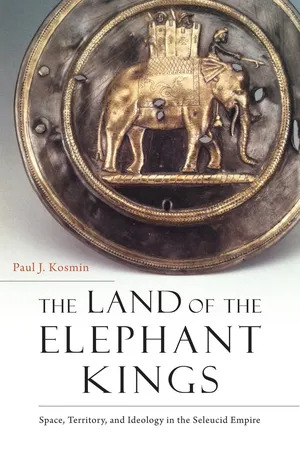![]()
Notes
Introduction
1. For discussion and plan of the Karasis fort, see Radt 2011 and Chapter 7, pp. 201–202.
2. AD -273 B Rev. 30–32.
3. 1 Macc. 6:43–46 with Joseph. AJ 12.373–374 and BJ 1.41–45.
4. Plut. Demetr. 25.4–9 and Mor. Prae. ger. reip. 823c–e; Athen. Deipn. 6.261b; see p. 279n44.
5. Kosmin 2013b; see also Alonso Troncoso 2013 and Iossif and Lorber 2010.
6. Libanius Or. 11.90.
7. Lucian, Zeuxis 11; Steph. Byz. s.v. Βοῦρα (see Bieńkowski 1929: 148).
8. Suda s.v. Σιμωνίδης (Μάγνης Σιπύλου).
9. Cn. Octavius: Polyb. 31.2.11 with Cic. Phil. 9.4 and Plin. HN 34.5.24 (a very confused account); Eleazar Avaran: 1 Macc. 6:43–46 with Joseph. AJ 12.373–374 and BJ 1.41–45.
10. Henceforth, all dates are BCE unless otherwise qualified.
11. See, e.g., Grainger 2010: 416; Will 1966: 1.262–290; Tarn 1966: 4; Rostovtzeff 1941: 1.429–430.
12. Tarn 1966: 4.
13. Note that interpretations of the Ptolemaic kingdom are moving away from dirigiste, strong-state models; see, e.g., Manning 2010.
14. E.g., Capdetrey 2007; Shipley 2000: 293–307.
15. The Briant oeuvre and Kuhrt and Sherwin-White 1993 have been enormously important in uncovering this debt.
16. E.g., Bingen 2007: 59–60; Austin 1986: 456–457; Gruen 1985: 259; Bickerman 1938: 7; Bevan 1902: 1.57.
17. Kuhrt and Sherwin-White 1993. Topoi 4 (1994) offers a range of critical scholarly responses to this work; I have found Briant 1994 particularly instructive.
18. Ma 2002.
19. Capdetrey 2007.
20. Primo 2009.
21. The bibliography is enormous. See, e.g., Lefebvre 1991; Certeau 1984; Foucault 1986; Harvey 2001 and 2009; Feld and Basso 1996; Gregory 1994; Said 2000; Soja 1989; Tuan 1974 and 1977; Warf and Arias 2009; Helms 1988; Streicker 1997.
22. E.g., Smith 2003.
23. E.g., Thonemann 2012; Malkin 2011; Horden and Purcell 2000.
24. E.g., Thalmann 2011; Selden 1998.
25. E.g., Nicolet 1988; see Purcell 1990 review.
26. For discussion and plans, see Chapters 7 and 8.
27. Tens of thousands of these “bullae,” often stamped with official seals, have been excavated from public and private archives in Seleucia-on-the-Tigris; see Invernizzi 2004, Rostovtzeff 1932, and Aperghis 2004: 154–156. They are of invaluable assistance in the reconstruction of Seleucid glyptic art and taxation systems.
28. The Diary tablets, now held in the British Museum, have been edited and translated by Abraham Sachs and Hermann Hunger, in their Astronomical Diaries and Related Texts from Babylonia (Vienna, 1988–1996), abbreviated in this book as AD.
29. The Chronicle tablets, also at the British Museum, are in the process of being reedited and translated by Irving Finkel and Robert van der Spek as Babylonian Chronicles of the Hellenistic Period, abbreviated in this book as BCHP; they are published online with commentary at www.livius.org/cg-cm/chronicles/chron00.html. Older editions include Grayson 1975 and Glassner 2004.
30. The most important corpora are Rougemont’s Inscriptions grecques d’Iran et d’Asie centrale (London, 2012), abbreviated in this book as IGIAC; de Rossi’s Iscrizioni dello estremo oriente Greco (Bonn, 2004), abbreviated as IEOG; Dittenberger’s Orientis Graeci Inscriptiones Selectae (Leipzig, 1903), abbreviated as OGIS; Welles’ Royal Correspondence in the Hellenistic Period (London, 1934), abbreviated as RC; and the epigraphic appendix to John Ma’s Antiochus III and the Cities of Western Asia Minor (Oxford, 2002), abbreviated as Ma. Up-to-date bibliography can be found by year and lemma in the annual Supplementum Epigraphicum Graecum, known as SEG.
31. We are fortunate to possess the illustrated and invaluable numismatic catalogues of Arthur Houghton and Catherine Lorber, Seleucid Coins: A Comprehensive Catalogue. Part 1: Seleucus I through Antiochus III (London, 2002), and Arthur Houghton, Catherine Lorber, and Oliver Hoover, Seleucid Coins: A Comprehensive Catalogue. Part 2: Seleucus IV through Antiochus XIII (London, 2008).
32. Zechariah 4:6.
33. They are not found, for instance, in Primo’s 2009 survey of historiography produced by or about the Seleucids; see Kosmin 2009.
34. The fragments of the lost Greek historians were collected by Felix Jacoby in his magisterial Die Fragmente der griechischen Historiker (Berlin, 1923–), abbreviated as FGrHist. The work is being reedited, extended, and translated into English by Brill’s New Jacoby, or BNJ, under the direction of Ian Worthington; it can be found at http://referenceworks.brillonline.com.
35. See Lebreton 2005: 656–657.
36. For discussion of the natural resources and agricultural productivity of each region, see Aperghis 2004: 35–86 and Cary 1949, with bibliography. For Anatolia, see Mitchell 1993 and Magie 1950, and for the Iranian world, Frye 1984.
37. Potts 1999: 10...
